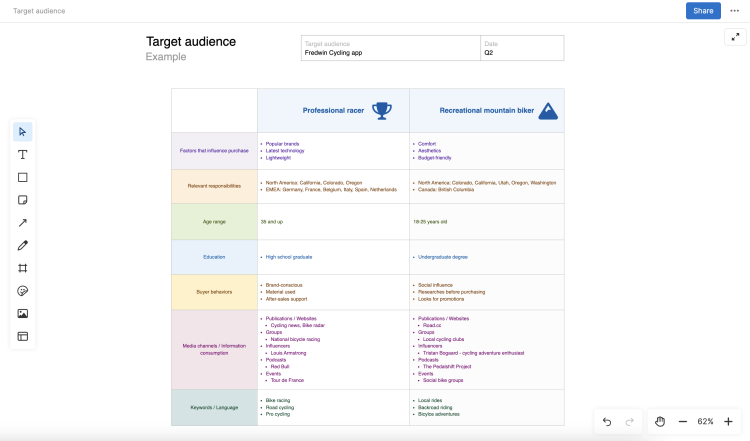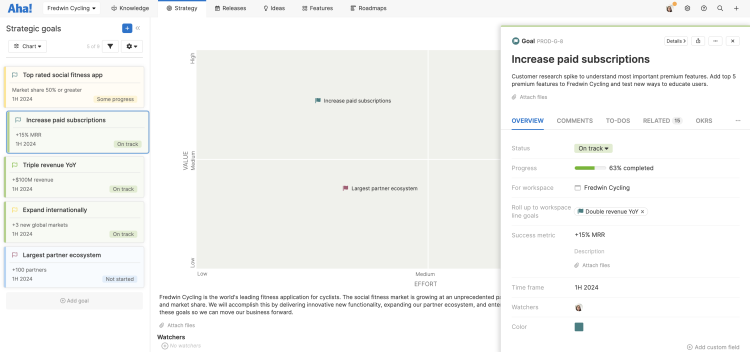What is a marketing strategy?
A clear marketing strategy is essential for business success. It defines the long-term plan for how a product or service will achieve and maintain a competitive advantage in an identified market. Establishing this upfront aligns the organization around how you will reach your target audience, explain the benefits of your offering to them, and encourage them to become customers.
Why is marketing strategy important?
Setting a marketing strategy is essential to keeping your team in sync and performing well. It aligns the entire company around shared market, business, and product assumptions. This is key to launching campaigns and promotional activities that effectively engage potential customers, drive revenue, build brand awareness, and strengthen the relationship with existing customers.
Your marketing strategy should establish:
Goals that determine how success will be measured
High-level efforts needed to achieve your goals
Who will get the most value from your product or service
What you know about the target market
Benefits of using your product or service
How to reach and communicate with your ideal customer
How to establish a sustainable competitive advantage
How to create a marketing strategy
Your strategy sets the direction for your everyday marketing activities. This keeps the team focused on what matters most — so you can successfully acquire, keep, and grow customers.
Set marketing goals
Before you define your marketing goals, you must have a clear understanding of your company’s overall vision and goals. This allows you to work backwards, setting marketing goals that serve business objectives. For example, if the business goal is to increase revenue by 30 percent, consider marketing goals around increasing the number of qualified leads or the trial-to-paid conversion rate so you can achieve this.
Here are some examples of marketing goals:
Goal: Drive leads to inside sales Metric: +500 a month |
Goal: Raise trial-to-paid conversion rate Metric:+ 5% |
Goal: Enhance social media presence Metric: +800,000 followers by year end |
Setting goals that are measurable and time-bound helps you demonstrate how marketing will deliver against the company’s goals. It also helps the team plan campaigns and promotional activities that deliver against companywide strategic directives.
Identify the target market
Your target market is the group of customers most likely to buy your product or service because it provides a meaningful benefit to them. This is determined through an in-depth understanding of customers who want or need what you are offering. It is important to identify specific customer segments within your overall market so you can refine your marketing approach for each group.
Distill your analysis of each customer segment to include the following information:
Geographic, demographic, and behavioral characteristics
Market size and growth potential
Competitive activity
Risk factors
Approach for serving the segment
This exercise helps you evaluate market opportunities and target the people most likely to buy your products. Once you have defined your customer segments, create detailed personas that describe your ideal customer. Include key characteristics, such as their goals, challenges, likes, and dislikes. This helps the marketing team craft messaging that is tailored for each audience.
To help you get started, try this target audience template. It will help you document the defining characteristics of your target personas — so you can create a strategy that resonates.
Define your target audience in Aha! software. Sign up for a free trial.

Define marketing initiatives
Initiatives are the high-level efforts you will implement to achieve the marketing goals. They should be set in a way that reflects the structure of your marketing team. For example, they might be organized by function (such as product marketing, content, and digital) or by market segment (such as consumer, small/medium business, and enterprise).
You likely have many options for initiatives based on market and customer opportunities that could move your business forward. Consider each one based on the potential business value and the effort required to accomplish it.
Here are some examples of marketing initiatives:
Lead mobile app launch
Enhance sales training
Start a webinar series
Launch social media campaign
Introduce referral program
Link your goals and initiatives to show how your marketing strategy ties together. This makes it easier to track progress as the actual work gets underway and keeps the team aligned around what matters the most.

Conduct market analysis
Evaluate the current and future attractiveness of your target market. This is essential to build a sustainable business that connects the overall market need with what really matters to your customers.
Your analysis should consider a variety of quantitative and qualitative factors that address the following questions:
What is the current size of the market?
What is the projected growth for the future?
What are the current market trends and how could they impact your business?
How does your product or service satisfy a market need?
What external factors influence the need for your product or service?
What are the challenges that might get in your way?
What alternatives are available to your potential customers?
Who are the main competitors? What are their strengths and weaknesses?
What are your strengths and weaknesses?
What unique value does your product or service provide?
Considering these questions helps you assess market opportunities and threats — so you can define a marketing strategy that sets you apart from the competition. There are a number of models available to structure your analysis, such as SWOT, Porter’s 5 Forces, and PESTLE. Use these strategic planning techniques to help you gain an in-depth understanding of the market environment and establish where you fit.
Craft your positioning and messaging
Your positioning strategy determines what you will communicate in the market. It captures how you will explain your product’s unique attributes to customers, drawing on a deep understanding of what they value the most. This helps you establish a position in the market that aligns with what your target customers want.
Here are the key elements to include in your positioning strategy:
Vision
Mission
Market category
Tagline
Customer challenges
Company and product differentiators
Core attributes you want to highlight
Distilling the problems your product solves and the value it provides helps the marketing team describe the product in a way that resonates with potential customers. It also allows you to create a concise positioning statement that explains how your product addresses customers’ needs better than any other solution.
Here is an an example of how to structure your positioning statement:
For (target customer) who (statement of the need), the (product) is a (product category) that (key benefit). Unlike (primary competitive alternative), our product (statement of primary differentiation).
Use the positioning statement as a guidepost to ensure your marketing strategy and tactics deliver on your promise to customers.
Identify the key benefits
Customers buy a product or service because it fulfills a want or need. Marketing is how potential customers learn about a product and determine if it might be a good fit. Your ability to articulate the key benefits your product provides is, therefore, critical to business success.
To communicate with potential customers in a meaningful way requires a deep understanding of your product and the problems it solves. Communicating the benefits gives meaning to features and helps buyers make an informed choice of the value they will receive by purchasing the product.
Including this information in your marketing strategy helps the team consistently describe why potential customers are going to love your product. This is key to launching integrated campaigns that reinforce the same value proposition across all social channels, advertisements, and company-published content.
Define your marketing mix
The marketing mix captures all the the elements needed to successfully promote your product. This is based on a model commonly referred to as the 10ps. It helps you formulate the best approach for bringing your product to market.
The elements included in the 10ps marketing matrix are:
Product: Primary way you satisfy your customer's needs
Price: Amount it costs a customer to purchase your product
People: Individuals who help to deliver your product
Process: How you deliver products to your customers
Promotion: Channels you use to communicate your product
Programs: The specific activities you use to promote your product
Place: Method of distribution for your product
Physical environment: Space in which you interact with customers to deliver your product
Partners: Other organizations that help you build or sell your product
Positioning: How you describe the key attributes of your product.
Use the 10ps of marketing to define and review your strategy. It helps you understand the variables you can control and how they interact so you can grow satisfied and loyal customers.

How to use a marketing strategy
A marketing strategy establishes how you will achieve your company’s vision, mission, and business goals. It brings together core building blocks that show a comprehensive understanding of the market and where your product or service fits.
Your strategy should be clearly articulated and easily accessible to the team. This keeps everyone aligned on the long-term plan and how success will be measured. You will need to review your strategy regularly as market conditions change and you learn more about what your customers want and need. This ensures that your marketing efforts stay in sync with the business and, most importantly, effectively engage your customers.
Plan, collaborate, and launch — all in one tool. Try Aha! free for 30 days.